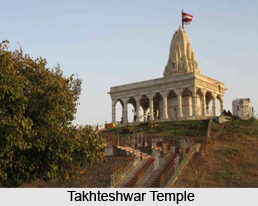 Bhavnagar district is in Gujarat state, with Bhavnagar city serving as the administrative headquarters of the district. It has a population of 2,469,630 of which 37.86% is urban (2001 census). It covers an area of 9940 sq. km. Bhavnagar borders with Ahmedabad and Surendranagar districts to the north, the Gulf of Cambay to the east and south and Amreli and Rajkot districts to the west. Once the capital of princely state, Bhavnagar was found in 1743 AD by Bhavsinhji Gohil (1703-64 AD) and was named after its founder and ruler and is now a flourishing port on the Gulf of Khambhat. For the tourist it is a convenient base for the visits to the town of Palitana and the sacred hill of Shatrunjaya. Bhavnagar is a coastal city with ports, salt works, shipbuilding and ship breaking yards along its coast. Bhavnagar is the 5th largest city of Gujarat, the 2nd largest in Saurashtra region. A city with rich history, Bhavnagar is also called the cultural capital of the Saurashtra region.
Bhavnagar district is in Gujarat state, with Bhavnagar city serving as the administrative headquarters of the district. It has a population of 2,469,630 of which 37.86% is urban (2001 census). It covers an area of 9940 sq. km. Bhavnagar borders with Ahmedabad and Surendranagar districts to the north, the Gulf of Cambay to the east and south and Amreli and Rajkot districts to the west. Once the capital of princely state, Bhavnagar was found in 1743 AD by Bhavsinhji Gohil (1703-64 AD) and was named after its founder and ruler and is now a flourishing port on the Gulf of Khambhat. For the tourist it is a convenient base for the visits to the town of Palitana and the sacred hill of Shatrunjaya. Bhavnagar is a coastal city with ports, salt works, shipbuilding and ship breaking yards along its coast. Bhavnagar is the 5th largest city of Gujarat, the 2nd largest in Saurashtra region. A city with rich history, Bhavnagar is also called the cultural capital of the Saurashtra region.
Takhteshwar Temple, Bhavnagar, Gujarat: With breathtaking view, Takhteshwar Temple was built on a hillock.
Gangajaha, Bhavnagar, Gujarat: Gangajaha Temple is the result of a Maharaja`s undying love for his Maharani, built in the 19th century.
Khodiyar Mata, Bhavnagar, Gujarat: Khodiyar Mata Temple has the deity enshrined, devoted to the rulers of the erstwhile Bhavnagar estate.
Gadhada, Bhavnagar, Gujarat: A classical architectural example, Gadhada houses the Swaminarayan Temple built by Sahajanand Swami.
Palitana, Bhavnagar, Gujarat: With almost uncountable number of temples located on its legendary hill, Palitana is the largest temple city in India.
Ghogha Tirth, Bhavnagar, Gujarat: Ghogha Tirth has been ravaged many a times, but it still stands tall, bearing the proof of history.





















